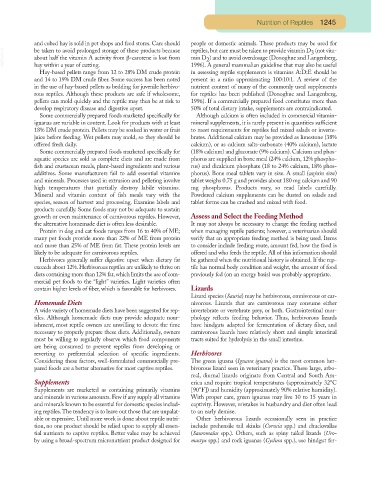Page 1195 - Small Animal Clinical Nutrition 5th Edition
P. 1195
Nutrition of Reptiles 1245
and cubed hay is sold in pet shops and feed stores. Care should people or domestic animals. These products may be used for
VetBooks.ir be taken to avoid prolonged storage of these products because reptiles, but care must be taken to provide vitamin D (not vita-
3
min D ) and to avoid overdosage (Donoghue and Langenberg,
about half the vitamin A activity from β-carotene is lost from
2
1996). A general mammalian guideline that may also be useful
hay within a year of cutting.
Hay-based pellets range from 12 to 28% DM crude protein in assessing reptile supplements is vitamins A:D:E should be
and 14 to 19% DM crude fiber. Some success has been noted present in a ratio approximating 100:10:1. A review of the
in the use of hay-based pellets as bedding for juvenile herbivo- nutrient content of many of the commonly used supplements
rous reptiles. Although these products are safe if wholesome, for reptiles has been published (Donoghue and Langenberg,
pellets can mold quickly and the reptile may then be at risk to 1996). If a commercially prepared food constitutes more than
develop respiratory disease and digestive upset. 50% of total dietary intake, supplements are contraindicated.
Some commercially prepared foods marketed specifically for Although calcium is often included in commercial vitamin-
iguanas are variable in content. Look for products with at least mineral supplements, it is rarely present in quantities sufficient
18% DM crude protein. Pellets may be soaked in water or fruit to meet requirements for reptiles fed mixed salads or inverte-
juice before feeding. Wet pellets may mold, so they should be brates. Additional calcium may be provided as limestone (38%
offered fresh daily. calcium), or as calcium salts-carbonate (40% calcium), lactate
Some commercially prepared foods marketed specifically for (18% calcium) and gluconate (9% calcium). Calcium and phos-
aquatic species are sold as complete diets and are made from phorus are supplied in bone meal (24% calcium, 12% phospho-
fish and crustacean meals, plant-based ingredients and various rus) and dicalcium phosphate (18 to 24% calcium, 18% phos-
additives. Some manufacturers fail to add essential vitamins phorus). Bone meal tablets vary in size. A small (aspirin size)
and minerals. Processes used in extrusion and pelleting involve tablet weighs 0.75 g and provides about 180 mg calcium and 90
high temperatures that partially destroy labile vitamins. mg phosphorus. Products vary, so read labels carefully.
Mineral and vitamin content of fish meals vary with the Powdered calcium supplements can be dusted on salads and
species, season of harvest and processing. Examine labels and tablet forms can be crushed and mixed with food.
products carefully. Some foods may not be adequate to sustain
growth or even maintenance of carnivorous reptiles. However, Assess and Select the Feeding Method
the alternative homemade diet is often less desirable. It may not always be necessary to change the feeding method
Protein in dog and cat foods ranges from 16 to 40% of ME; when managing reptile patients; however, a veterinarian should
many pet foods provide more than 22% of ME from protein verify that an appropriate feeding method is being used. Items
and more than 25% of ME from fat. These protein levels are to consider include feeding route, amount fed, how the food is
likely to be adequate for carnivorous reptiles. offered and who feeds the reptile. All of this information should
Herbivores generally suffer digestive upset when dietary fat be gathered when the nutritional history is obtained. If the rep-
exceeds about 12%. Herbivorous reptiles are unlikely to thrive on tile has normal body condition and weight, the amount of food
diets containing more than 12% fat,which limits the use of com- previously fed (on an energy basis) was probably appropriate.
mercial pet foods to the “light” varieties. Light varieties often
contain higher levels of fiber, which is favorable for herbivores. Lizards
Lizard species (Sauria) may be herbivorous, omnivorous or car-
Homemade Diets nivorous. Lizards that are carnivorous may consume either
A wide variety of homemade diets have been suggested for rep- invertebrate or vertebrate prey, or both. Gastrointestinal mor-
tiles. Although homemade diets may provide adequate nour- phology reflects feeding behavior. Thus, herbivorous lizards
ishment, most reptile owners are unwilling to devote the time have hindguts adapted for fermentation of dietary fiber, and
necessary to properly prepare these diets. Additionally, owners carnivorous lizards have relatively short and simple intestinal
must be willing to regularly observe which food components tracts suited for hydrolysis in the small intestine.
are being consumed to prevent reptiles from developing or
reverting to preferential selection of specific ingredients. Herbivores
Considering these factors, well-formulated commercially pre- The green iguana (Iguana iguana) is the most common her-
pared foods are a better alternative for most captive reptiles. bivorous lizard seen in veterinary practice. These large, arbo-
real, diurnal lizards originate from Central and South Am-
Supplements erica and require tropical temperatures (approximately 32°C
Supplements are marketed as containing primarily vitamins [90°F]) and humidity (approximately 90% relative humidity).
and minerals in various amounts. Few if any supply all vitamins With proper care, green iguanas may live 10 to 15 years in
and minerals known to be essential for domestic species includ- captivity. However, mistakes in husbandry and diet often lead
ing reptiles.The tendency is to leave out those that are unpalat- to an early demise.
able or expensive. Until more work is done about reptile nutri- Other herbivorous lizards occasionally seen in practice
tion, no one product should be relied upon to supply all essen- include prehensile tail skinks (Corucia spp.) and chuckwallas
tial nutrients to captive reptiles. Better value may be achieved (Sauromalus spp.). Others, such as spiny tailed lizards (Uro-
by using a broad-spectrum micronutrient product designed for mastyx spp.) and rock iguanas (Cyclura spp.), use hindgut fer-

